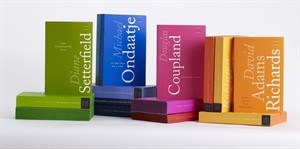
Books from Indigo's Colour Your Library program are shown in this undated handout photo. The Colour Your Library program, in which the covers have a spectrum of vibrant hues with matching spines, is one example of how companies are looking at new ways to market their print books to entice readers to buy them. THE CANADIAN PRESS/HO - Indigo
December 25, 2012 - 2:00 AM
TORONTO - The physical book is getting gussied up by some companies as its digital counterpart continues to thrive.
Both Indigo Books & Music and Random House of Canada say they're looking at new ways to market their print books to entice readers to buy them.
"We believe that for people to buy them for themselves or as gifts, they need to look great, so I think that's a good thing," says Brad Martin, president and CEO of Random House of Canada.
"I don't believe anybody believes that the physical format is ever going to go away and we've put a lot of effort into making some truly unique, beautiful books," adds Bahram Olfati, vice president of trade books at Indigo Books & Music Inc.
Martin says Random House is adding more "production value" to its physical books. That includes more deluxe paperbacks with French flaps and rough-cut or deckle edges, as well as specially designed endpaper.
"So they look a lot nicer," says Martin. "Or they have a matte/gloss finish or a deboss or an emboss, all kinds of combinations of those things."
Random House, which plans to merge with Penguin, is also working with Indigo on special physical editions of popular books from esteemed authors including Michael Ondaatje, Margaret Atwood and Vincent Lam.
The Colour Your Library program, in which the covers have a spectrum of vibrant hues with matching spines, is intended to make books look good on readers' shelves, says Olfati.
"They're not just your everyday, average book," he adds. "These books actually make a statement. So not only are they beautiful on the outside, they're amazing books on the inside, too."
Indigo has also worked with other publishers, including Phaidon and Taschen, to create exclusive lines of gift books.
Treating books as collectibles gives readers "pause," notes Olfati.
"One thing about an ebook, once it goes into that digital sphere, you never know that you have it. It becomes a line, it becomes part of an index," he says.
"Whereas if you have a physical book at home, you're always going to reference it, you're always going to see it, it's always going to be on your mind."
Such efforts have come during another year in which ebook sales continued to soar.
Martin says Random House's ebook sales in 2012 were nearly double those in 2011.
And in October, a report by the non-profit industry group BookNet Canada showed ebook sales represented an estimated 16.3 per cent of the overall book market in Canada.
Print sales still dominated, though, with paperbacks representing an estimated 56.7 per cent of the market and hardcovers making up 23.6 per cent.
"We're not expecting print books to disappear anytime soon," says Martin.
"There may be less of them as my generation moves along and the younger generations — that are more digitally adept — come along. However, we're not actually finding in the younger demographics that people aren't buying books."
Nova Scotia-based Gaspereau Press, a small publisher known for creating high-quality books in hand-crafted fashion, says "it would be amazing" if bigger companies reinvested in the physical book.
"But I have my doubts," adds Gaspereau co-owner Andrew Steeves. "They're going to have to dig deep to even remember where quality resides. And I'm here to encourage that. I want them to do that."
Steeves notes the broader trade has "invested less and less in the physical book" for a couple of generations now in order to cut costs.
"The cloths that we use when we do hardcovers are not as good, more and more mystery meat in our papers," he says.
"We have, over time, disembodied books. So the leap to the wholly disembodied electronic text, it's only logical, because we've been going down that path so long of ignoring the physical properties, discounting the physical properties entirely."
But with a renewed focus on the quality of the physical book, its future could look like that of another medium, says author Tamas Dobozy.
"The best analogy I've heard, and I think this is really good, is vinyl. The book is going to be vinyl," says Dobozy, winner of this year's Rogers Writers' Trust Fiction Prize for "Siege 13."
"It's going to be the reading experience you can't get except through that medium and people are still going to want it, people are still going to collect it, but it could become more niche-oriented in the way vinyl's becoming niche-oriented for recordings."
But "vinyl is a small piece of the overall music market, and it's a very collectible market," notes Martin.
"There is an analogy to be made there. I'm not sure that physical books are going to go to that sort of small a piece of the overall category."
Olfati also doesn't see the book going the way of vinyl.
"There are people that want to have books in their hands to read and not all books will become collectible but it's just the fun and the appeal of reading a book," he says.
News from © The Canadian Press, 2012